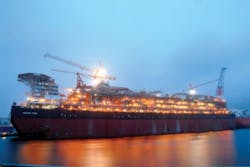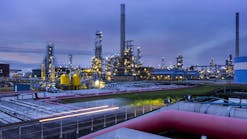PAULA DITTRICK
Senior Staff Writer
Carbon capture technology has yet to be demonstrated on an industrial scale, but a joint venture of the Norwegian government, Statoil, Sasol, and Royal Dutch Shell PLC is intended to help change that through a technology testing center now under construction. Construction is more than 70% complete on the Technology Center Mongstad (TCM) at Statoil's Mongstad, Norway, refinery northwest of Bergen, TCM Managing Director Tore Amundsen told an Offshore Technology Conference luncheon on May 3 in Houston.
He also addressed a May 5 carbon capture and storage (CCS) conference organized by the British, Norwegian, and Canadian consulates in Houston.
CCS is touted as a way to reduce carbon dioxide emissions into the atmosphere, but researchers must prove CCS can be done on a large enough scale to stabilize CO2 concentration levels. They also must prove the economic feasibility of carbon capture, which is the most expensive element of CCS.
Amundsen calls the project "the largest and most versatile demonstration of CO2 capture technologies to date." TCM's goal is to assist in developing more efficient, cheaper CCS technology.
Testing technology
The center will test two different types of carbon capture technologies from two different sources of CO2. Researchers will have access to flue gas from a gas-fired combined heat and power plant and flue gas from the refinery's catalytic cracker. The CO2 content from the CHP plant and cat cracker is about 3.5% and 13%, respectively, enabling TCM to investigate capture technologies relevant for coal and gas power plants and other industrial applications.
Testing of carbon capture technology is scheduled to start late this year at Technology Center Mongstad at Statoil's Mongstad refinery in Norway. Photo from Statoil, taken by Helge Hansen.
TCM will perform tests based upon a chilled ammonia process from Alstrom and an amine process from Aker Clean Carbon. Both post-combustion capture technologies are designed to capture 85% of CO2 contained in the flue gas.
Designers planned TCM's capacity to capture about 100,000 tonnes/year of CO2 with 80,000 tpy of that collected through chilled ammonia capture and 20,000 tpy through amine-based capture. Amundsen noted TCM tests won't actually run for 12 months.
Technology vendors initially will cooperate with TCM to test their respective technologies. After the first year, TCM researchers will be responsible for developing test programs.
While in Houston, Amundsen acknowledged concerns exist about potential cancer-causing compounds formed during amine-based CO2 capture. The Norwegian Institute of Public Health recommends monitoring the concentration of both nitrosamines and nitramines in air and water.
"We don't know the impact of large-scale amine technology," he said, adding he is confident TCM's emissions will not cause health problems, but researchers are uncertain about its use on a prolonged commercial scale in industrial areas where nitrosamine and nitramines might already exist.
Network building
European CCS experts visited TCM in February. TCM is the biggest unit in a consortium called European Carbon Dioxide Capture and Storage Laboratory (ECCSEL), which includes selected CCS research centers from 10 European countries. ECCSEL's mission is to develop a European research network.
ECCSEL laboratories intend to provide an integrated foundation for the experimental research needed to develop improved CCS technologies. Scheduled to be in operation by 2015, ECCSEL began a 4-year preparatory phase on Jan. 1.
For decades, the oil industry has injected CO2 underground in enhanced oil recovery projects. It's no surprise that oil companies are helping develop and finance TCM or that it's being built at a refinery.
More Oil & Gas Journal Current Issue Articles
More Oil & Gas Journal Archives Issue Articles
View Oil and Gas Articles on PennEnergy.com



